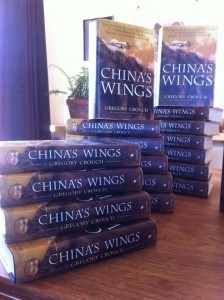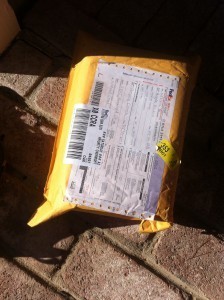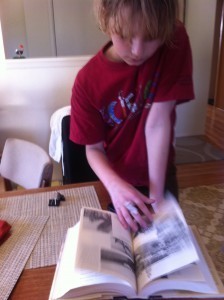Gregory Crouch's Blog, page 38
February 14, 2012
Advance copies in the house!
February 6, 2012
China's Wings — further reading
China's Wings bibliography stretches to nine printed pages, most of which I read cover to cover, while sampling generously from the rest. I'd like to pull out a few of my favorites for recommendation — in no particular order:
Wind, Sand and Stars by Antoine de Saint Exupery: His stories of flying the airmail during aviation's wilderness era. It's an all-time favorite book of mine, and one of the reasons I always smile when I see a young woman emblazoned in Aeropostale.
Quartered Safe Out Here by George MacDonald Fraser: and yes, that's the same man who authored the classic Flashman series. Quartered Safe is his memoir of campaigning in Burma with the British 14th Army, and in my estimation it ranks with E.B. Sledge's With the Old Breed as one of the two greatest memoirs of the Second World War.
North to the Orient by Anne Morrow Lindbergh. She won the first National Book Award for general non-fiction for this one, about a flying adventure she took with her husband on a great circle route from New York to China in 1931. Interesting, and beautifully written. Relevant to my research, her section on the Yangtze River flood of 1931 provided great insights into the worst natural disaster in recorded history, trumping even the Indian Ocean Tsunami of 2004, which killed 200,000 people.
Fate is the Hunter by Ernest K. Gann. (In a clear case of don't judge a book by its cover, the edition I read must have the ugliest cover in the history of publishing.) The last great memoir of aviation's Golden Age.
The Rape of Nanking by Iris Chang. An extraordinarily disturbing book about one of the worst episodes in the whole sordid history of the human race. This one gave me nightmares.
The Chinese in America, also by Iris Chang. I have nothing but respect for Chinese immigrants. In my mind, our country is the stronger and better for their contribution.
No Hurry to Get Home by Emily "Mickey" Hahn. Free-thinking, spicy Mickey Hahn went to China in the late 1930s as a correspondent for The New Yorker. This collection of short stories is one of the results of that happy relationship. Her absolutely classic essay, "The Big Smoke" begins with the memorable line "Though I had always wanted to be an opium addict, I can't claim that as the reason I went to China" and gets better from there as it details her opium addiction and eventual cure.
China to Me, also by Mickey Hahn. Her thrilling memoir of her years in Asia. Beautifully written. She knew all the main players in China's Wings and her and her notorious pet gibbons featured in an anecdote I truly adored. Taking it out of the manuscript was the hardest single cut I made. I'm still not sure it was the right decision, but never fear, it'll find its way into this blog sometime soon. And I'll confess to having more than a little bit of a crush on Mickey Hahn.
Shanghai: the Rise & Fall of a Decadent City by Stella Dong. A breezy and entertaining history of the city about which an American missionary once said, "If God allows Shanghai to exist, he owes an apology to Sodom and Gomorrah." My kind of town.
Tonya, by Gregory Boyington. A quirky, interesting novel authored by the AVG fighter pilot, Marine Corps ace, and Medal of Honor recipient whose most quoted quip, "Just name a hero, and I'll prove he's a bum."
Sand Against the Wind: Joseph W. Stilwell and the American Experience in China, 1911-1945 by Barbara Tuchman. A Pulitzer Prize winner and fascinating book about the man who might be the graduate of my Alma Mata who interests me most. Sent to China, Burma, and India in early 1942, Stilwell certainly got the worst assignment of any senior officer.
Road of Bones, by Fergal Keene. High-quality battle narrative about the brutal Siege of Kohima in 1944.
The Sand Pebbles by Richard McKenna. A novel before it was a film starring Steve McQueen, and a fascinating look at life in the U.S. Navy's nearly forgotten Yangtze Patrol.
Flying Tigers by Dan Ford. The story of the American Volunteer Group made fascinating and relevant to me because so many AVG men transferred to CNAC when the Flying Tigers disbanded in July, 1942. I had the honor of interviewing two of them in detail — Dick Rossi and Joe Rosbert — and of shaking the hand of a third, Robert "Catfish" Raine.
Stilwell's Mission to China, Stilwell's Command Problems, and Time Runs Out in the CBI, the Army's official three-volume history of the China-Burma-India theater of World War II, by Charles F. Romanus and Riley Sunderland. These aren't light reading, not by any means, but they're the bottom line record of the U.S. Army in the CBI, and they're by far the best of the official Army histories I've read. (Although granted, I haven't read them all.)
Franklin D. Roosevelt and American Foreign Policy, 1932-19435 by Robert M. Dallek. The bottom line on the topic.
The Lady and the Tigers by Olga Greenlaw. A charming memoir by a woman who served with Claire Chennault's American volunteer group.
China: The Remembered Life by Paul Frillman. Memoir of missionary life in China written by the AVG's chaplain.
No Ordinary Time, by Doris Kearns Goodwin. Wonderfully told tale of the Roosevelt White House by a top-shelf historian. And like Mickey Hahn above, I'll cop to having a bit of a crush on her.
February 2, 2012
A literary connection: Wind, Sand and Stars to China's Wings
I'm ginning up a little radio blurb discussing three books from aviation's "Golden Age," and to that end I've been reading Antoine de Saint Exupery's classic Wind, Sand and Stars for what must be the fifth or sixth time since I discovered it in the mid-1990s.
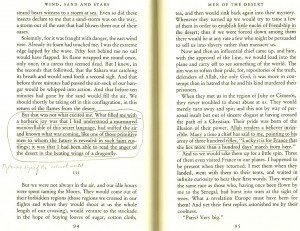
A page of my marginalia
My copy is filled with marginalia, relics of my careful reading (and re-reading) from 2000, the year I wrote Enduring Patagonia.
However, this recent reading is the first time I've gone through Wind, Sand and Stars without an eye toward its connections and relevance to climbing.
I'm happy to report that it's every bit as excellent, and it was with wonder that I discovered Wind, Sand and Stars direct connection to the work I've done with China's Wings. Here it is; it's a grim quote, albeit beautifully penned:
"Every week men sit comfortably at the cinema and look on at the bombardment of some Shanghai or other, some Guernica, and marvel without a trace of horror at the long fringes of ash and soot that twist their slow way into the sky from those man-made volcanoes. Yet we all know that together with the grain in the grainaries, with the heritage of generations of men, with the treasures of families, it is the burning flesh of children and their elders that, dissipated in smoke, is slowly fertilizing those black cumuli."
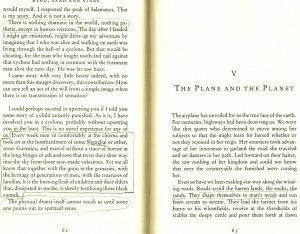 The Shanghai Saint Exupery is referring to is the Battle of Shanghai fought from mid-August to mid-November, 1937, between the Japanese invaders and the armies of Chiang Kai-shek. It was one of the first battles of what we now call the Second World War, it was one biggest battles ever fought, and it has been largely forgotten, overshadowed by those fought once the western nations got involved.
The Shanghai Saint Exupery is referring to is the Battle of Shanghai fought from mid-August to mid-November, 1937, between the Japanese invaders and the armies of Chiang Kai-shek. It was one of the first battles of what we now call the Second World War, it was one biggest battles ever fought, and it has been largely forgotten, overshadowed by those fought once the western nations got involved.
Shanghai was the fifth or sixth biggest city in the world in 1937 (behind London, New York, Toyko, Berlin, and, possibly, Chicago), and the battle near-completely destroyed "Greater Shanghai" — that part of the city outside of the International Settlement and the French Concession. More than a quarter of a million people died in the fight, and it's the backdrop of China's Wings' second part, entitled "War."
Here's the quote I used on the front piece of that part, from The Battle for Asia by Edgar Snow:
"Great battles, in which thousands of men are torn apart, are forgotten as easily as last year's Olympics."
Here's an album of photographs of the battle taken by Swiss photographer Karl Kenglebacher.
January 30, 2012
One of the great moments of my life
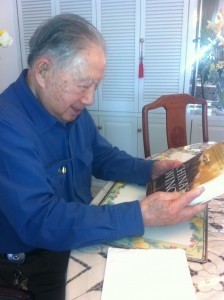 This afternoon, I completed the first part of the two-fold mission I set for myself when I embarked on this China's Wings project. My son Ryan and I drove to Moon Chin's house on the other side of San Francisco Bay and gave him one of my two advanced copies of China's Wings.
This afternoon, I completed the first part of the two-fold mission I set for myself when I embarked on this China's Wings project. My son Ryan and I drove to Moon Chin's house on the other side of San Francisco Bay and gave him one of my two advanced copies of China's Wings.
Watching his face glow as he unwrapped the book, cracked its cover, and took a first flip through its pages is one of the great moments of my life. A moment of total satisfaction. I'm absolutely thrilled with the finished product — it is exactly how I've been imagining it these last eight years.
I'm deeply honored that Moon trusted me to tell the CNAC story. Quite simply, I wouldn't have been able to do it without his wholehearted cooperation, and my most sincere hope is that I've been able to do the story justice.
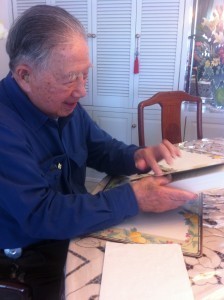 My favorite day in the whole researching and writing process was the day spent at the same table over which I passed him his book in these photos. I spent that day spent talking about the events of the Hong Kong evacuation of December 1941 with Moon, Frieda, and T.T. Chen, all of whom participated. Toward the end of the afternoon, I apologized for taking so much of their time, and Frieda chirped out, "Don't worry about it! This is all we sit around and talk about anyway."
My favorite day in the whole researching and writing process was the day spent at the same table over which I passed him his book in these photos. I spent that day spent talking about the events of the Hong Kong evacuation of December 1941 with Moon, Frieda, and T.T. Chen, all of whom participated. Toward the end of the afternoon, I apologized for taking so much of their time, and Frieda chirped out, "Don't worry about it! This is all we sit around and talk about anyway."
Through the years, Moon gave me dozens of hours of his time — he's one of the most remarkable men I've ever met. Here's my favorite picture of Moon Chin, taken in 1941, and here's one of him and me, taken at the CNAC reunion this past September. Earlier in this blog, I've shared some of the details of his remarkable life. The stories start here, in All Roads Led to Moon Chin, and works there way forward in time.
The second part of my China's Wings mission is to ensure that the story of the China National Aviation Corporation takes its rightful place in history. Aside from the incredible flying adventures, so many facets of this story are fascinating and significant: CNAC played a tremendously significant role in the American relationship with China in the 1930s and 40s — a time that continues to shape our relationship with the Middle Kingdom as it emerges from centuries of isolation and struggles to take its place among the world's great nations.
Without doubt, the China National Aviation Corporation is the most successful Sino-American partnership of all time. May there be many others.
It's truly a great story.
David Roberts' article
David Roberts has written a good and fair summary of the recent events on Cerro Torre for National Geographic Adventure.
January 28, 2012
A book at last!
This is a strange experience.
There it is. China's Wings. A book at last
No longer in my imagination.
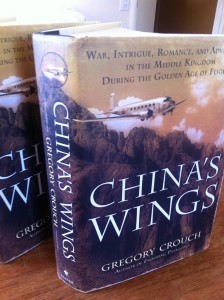
A book at last
January 26, 2012
A CNAC Short Snorter signed by movie star Jinx Falkenburg
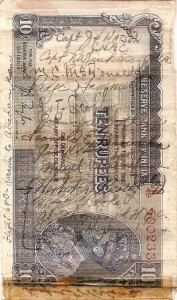
The front, signed by CNAC Captains Watson, Ridge Hammell, Bob Jenkins, Billy MacDonald, and Jimmy Scoff
Kai Friese, a writer and CNAC enthusiast in New Delhi, brought this to my attention yesterday — a short snorter signed by Ridge Hammell, Jimmy Scoff, Bob Jenkins, and Billy MacDonald (all of whom are CNAC pilots and characters in China's Wings). Short Snorters were banknotes signed by persons traveling together during the war — and if you signed a person's short snorter and that person could not produce it upon request, he or she owed you a drink.
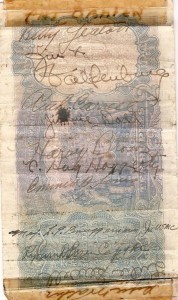 The back of the bill was signed by Hollywood movie star Jinx Falkenburg, who made a USO tour in the CBI in late 1944. Here are some photos of Jinx at "glamour girls of the silver screen," here's a picture of Jinx flying the Hump in 1944 that Kai directed me to yesterday, and here's one of Jinx doing a USO show that is simply spectacular.
The back of the bill was signed by Hollywood movie star Jinx Falkenburg, who made a USO tour in the CBI in late 1944. Here are some photos of Jinx at "glamour girls of the silver screen," here's a picture of Jinx flying the Hump in 1944 that Kai directed me to yesterday, and here's one of Jinx doing a USO show that is simply spectacular.
Ridge Hammell and Jimmy Scoff both feature quite prominently in the book. Hammell, along with ex-AVG ace Joe Rosbert, survived a plane crash high in the snowy mountains. Their epic 47-day trek back to civilization with badly damaged legs ranks as one of the great tales of mountain survival of all time. Jimmy Scoff's tales of wanton debauchery have colored every CNAC reunion I've attended, best of all being the time he shot the lock off a whorehouse door in Calcutta…
Neither Hammel nor Scoff survived the war, and it boggles my mind to see their signatures so clearly on these bills.
The Short Snorter Project is a website devoted to preserving short snorter history.
Interview w Jason Kruk, Hayden Kennedy, Rolando Garibotti, and Colin Haley
Here's an interview with Jason Kruk, Hayden Kennedy, Rolando Garibotti, and Colin Haley.
In what will pose difficulties for some, it's written in Spanish. Unfortunately, the translate button at the top produced gibberish, so I recommend reading in the original.
The article includes an interesting photo of the extracted bolts…
January 24, 2012
More on the Compressor Route
So I checked out of the net for a few days and scored classic surf with Mark and Susan Robsinson and Randy Leavitt "somewhere west of Goleta." We talked a lot about the Compressor Route news about which I posted last week, and I return to find even more amazing and breaking news from Cerro Torre — David Lama apparently free-climbed the Compressor Route, there was a "lynch mob" in El Chalten angry over the bolt-chopping, and more than 500 posts were added to the Supertopo thread.
I've got to process and ponder all this. In the meantime, I'll post some of my best photos taken on the Compressor Route.
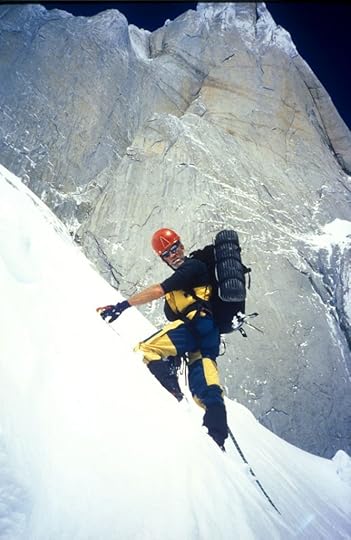
Jim Donini climbing toward the Col of Patience, the beginning of our attempt on the Compressor Route with Stefan Hiermaier that failed on the Compressor itself
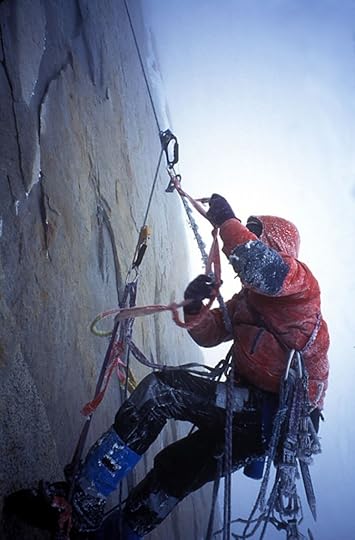
Me on the headwall close to the end of that attempt, just before Donini told Stefan: "Survival is not assured."
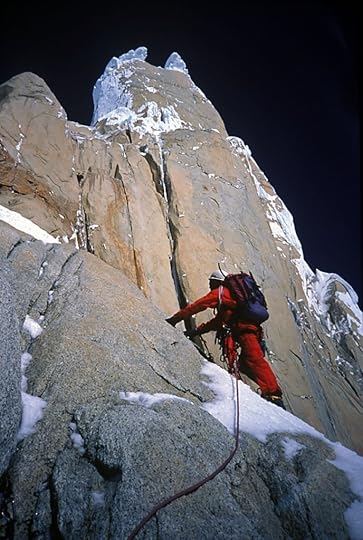
Charlie Fowler low on the route, above the Col of Patience
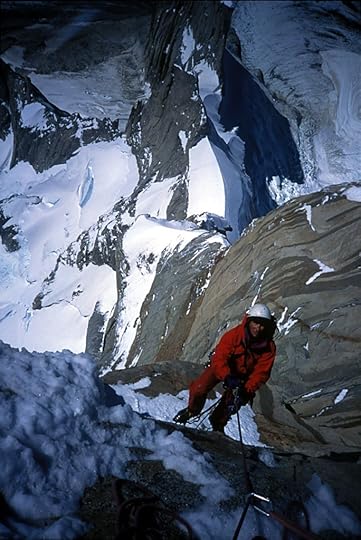
Charlie jumaring
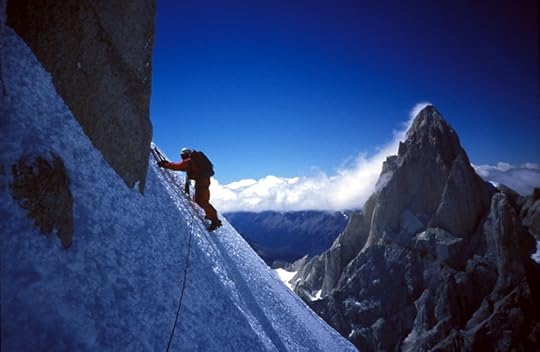
Charlie Fowler at the start of the Ice Towers
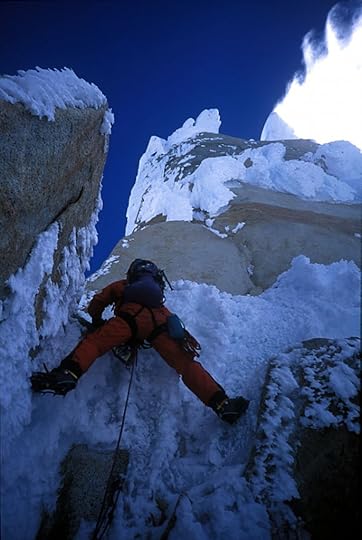
Charlie Fowler in the Ice Towers
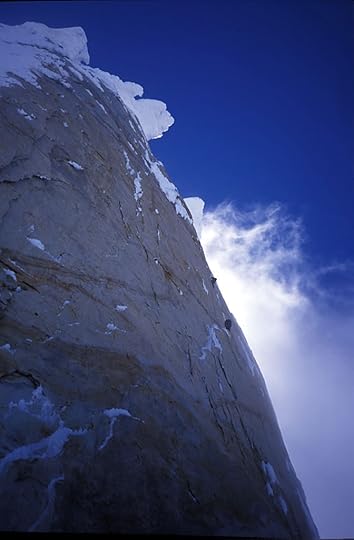
The headwall

Charlie Fowler at sunrise, after our summit bivy
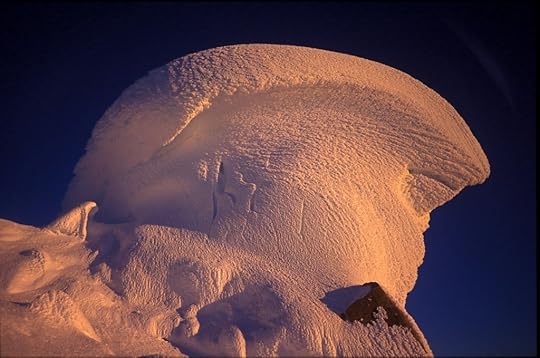
The summit mushroom at sunrise
China's Wings on Facebook
I've built a Facebook page for China's Wings, and if you "like" it with the button at the bottom of the sidebar on the right (or find and like it through FB search), you'll find a photo album of CNAC-related stuff that I've been building… lots of airplane and people pics from the '30s and '40s, as well as scans of travel posters, documents, pen and ink drawings, more modern pics of people in the book, etc.
I'm trying to add one photo a day (or every few days) to the album — I've got dozens, if not hundreds, of excellent stuff to add, so I should be able to keep this up for a while.
(And I'd love to get new stuff from CNAC people, too… so if you've got some, please do email 'em to me.)

